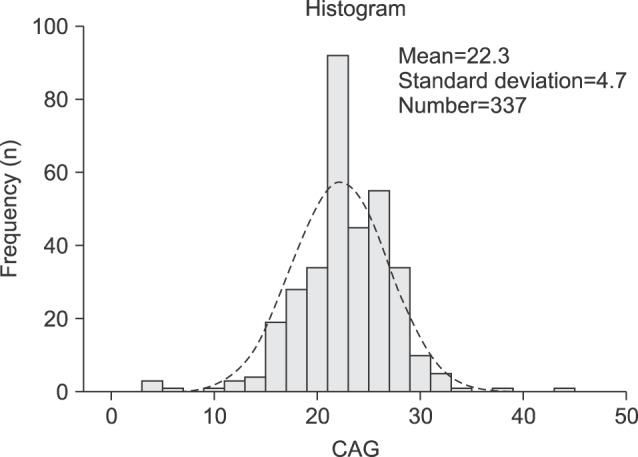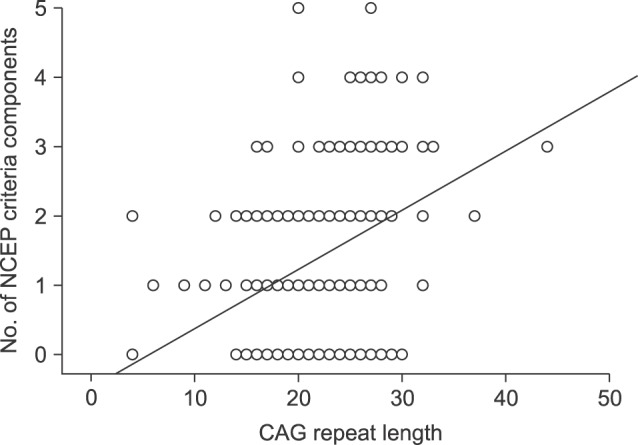World J Mens Health.
2018 Jan;36(1):73-78. 10.5534/wjmh.17029.
Positive Correlation between Androgen Receptor CAG Repeat Length and Metabolic Syndrome in a Korean Male Population
- Affiliations
-
- 1Department of Urology, Korea University College of Medicine, Seoul, Korea. dgmoon@korea.ac.kr
- 2Institute of Regenerative Medicine, Korea University, Seoul, Korea.
- 3Department of Urology, Chung-Ang University College of Medicine, Seoul, Korea.
- KMID: 2399174
- DOI: http://doi.org/10.5534/wjmh.17029
Abstract
- PURPOSE
In epidemiological studies, there are various associations of androgen receptor (AR) CAG with several diseases or phenotypes. However, the relationship between CAG repeat length and metabolic syndrome (MS) remains unclear, especially in Asian populations. This study was designed to evaluate the relationship between AR CAG repeat length polymorphism and MS in a Korean male population.
MATERIALS AND METHODS
We explored the relationship between AR CAG repeat length polymorphism and MS in a Korean male population (n=337) from 2013 to 2014. AR CAG repeat were determined by microsatellite fragment sizing. Components of MS and laboratory data (lipid profile, fasting glucose, and glycated hemoglobin (HbA1c)) were analyzed with AR CAG repeat length.
RESULTS
The mean AR CAG repeat length was 22.3±4.7. Sixty-nine men (20.5%) were diagnosed with MS. Men with MS showed significantly longer AR CAG repeat lengths compared with men without MS (26.2 vs. 21.4, p < 0.001). With increasing CAG repeat, the number of components meeting the NCEP criteria increased significantly. AR CAG repeat length was associated significantly with high density lipoprotein (HDL), triglyceride, and HbA1c levels. In the multivariate analysis, CAG repeat length, waist circumference, and levels of HDL were independently associated with MS. (odds ratio (OR)=1.37, 1.19 and 0.90, p < 0.001, 0.045, and 0.001, respectively).
CONCLUSIONS
AR CAG repeat length was associated with MS and laboratory test results, such as those for HDL, triglycerides, and HbA1c, in Korean males. Longer CAG repeat length was identified as a risk factor for MS in Korean males.
MeSH Terms
-
Asian Continental Ancestry Group
Epidemiologic Studies
Fasting
Glucose
Hemoglobin A, Glycosylated
Humans
Lipoproteins
Male*
Microsatellite Repeats
Multivariate Analysis
Phenotype
Receptors, Androgen*
Risk Factors
Triglycerides
Trinucleotide Repeats
Waist Circumference
Glucose
Lipoproteins
Receptors, Androgen
Triglycerides
Figure
Reference
-
1. Lubahn DB, Joseph DR, Sullivan PM, Willard HF, French FS, Wilson EM. Cloning of human androgen receptor complementary DNA and localization to the X chromosome. Science. 1988; 240:327–330. PMID: 3353727.
Article2. Goutou M, Sakka C, Stakias N, Stefanidis I, Koukoulis GN. AR CAG repeat length is not associated with serum gonadal steroids and lipid levels in healthy men. Int J Androl. 2009; 32:616–622. PMID: 18657194.
Article3. Travison TG, Shackelton R, Araujo AB, Morley JE, Williams RE, Clark RV, et al. Frailty, serum androgens, and the CAG repeat polymorphism: results from the Massachusetts Male Aging Study. J Clin Endocrinol Metab. 2010; 95:2746–2754. PMID: 20410235.
Article4. Zitzmann M, Gromoll J, von Eckardstein A, Nieschlag E. The CAG repeat polymorphism in the androgen receptor gene modulates body fat mass and serum concentrations of leptin and insulin in men. Diabetologia. 2003; 46:31–39. PMID: 12637980.
Article5. Ackerman CM, Lowe LP, Lee H, Hayes MG, Dyer AR, Metzger BE, et al. Ethnic variation in allele distribution of the androgen receptor (AR) (CAG)n repeat. J Androl. 2012; 33:210–215. PMID: 21597087.
Article6. Mhatre AN, Trifiro MA, Kaufman M, Kazemi-Esfarjani P, Figlewicz D, Rouleau G, et al. Reduced transcriptional regulatory competence of the androgen receptor in X-linked spinal and bulbar muscular atrophy. Nat Genet. 1993; 5:184–188. PMID: 8252045.
Article7. Lundin KB, Giwercman A, Richthoff J, Abrahamsson PA, Giwercman YL. No association between mutations in the human androgen receptor GGN repeat and inter-sex conditions. Mol Hum Reprod. 2003; 9:375–379. PMID: 12802043.
Article8. Alberti KG, Zimmet P, Shaw J. Metabolic syndrome: a new world-wide definition. A Consensus Statement from the International Diabetes Federation. Diabet Med. 2006; 23:469–480. PMID: 16681555.9. Skjaerpe PA, Giwercman YL, Giwercman A, Svartberg J. Androgen receptor gene polymorphism and the metabolic syndrome in 60–80 years old Norwegian men. Int J Androl. 2010; 33:500–506. PMID: 19207614.10. Svartberg J. Epidemiology: testosterone and the metabolic syndrome. Int J Impot Res. 2007; 19:124–128. PMID: 16858366.
Article11. Lauer MS, Fontanarosa PB. Updated guidelines for cholesterol management. JAMA. 2001; 285:2508–2509. PMID: 11368705.
Article12. Stanworth RD, Akhtar S, Channer KS, Jones TH. The role of androgen receptor CAG repeat polymorphism and other factors which affect the clinical response to testosterone replacement in metabolic syndrome and type 2 diabetes: TIMES2 sub-study. Eur J Endocrinol. 2013; 170:193–200. PMID: 24165020.
Article13. Stanworth RD, Kapoor D, Channer KS, Jones TH. Androgen receptor CAG repeat polymorphism is associated with serum testosterone levels, obesity and serum leptin in men with type 2 diabetes. Eur J Endocrinol. 2008; 159:739–746. PMID: 18805913.
Article14. Mouritsen A, Hagen CP, Sørensen K, Aksglaede L, Mieritz MG, Main KM, et al. Androgen receptor CAG repeat length is associated with body fat and serum SHBG in boys: a prospective cohort study. J Clin Endocrinol Metab. 2013; 98:E605–E609. PMID: 23393169.
Article15. Zitzmann M, Nieschlag E. The CAG repeat polymorphism within the androgen receptor gene and maleness. Int J Androl. 2003; 26:76–83. PMID: 12641825.16. Kim MJ, Kim JT, Cho SW, Kim SW, Shin CS, Park KS, et al. Androgen receptor gene CAG repeat polymorphism and effect of testosterone therapy in hypogonadal men in Korea. Endocrinol Metab. 2011; 26:225–231.
Article17. Kalyani RR, Dobs AS. Androgen deficiency, diabetes, and the metabolic syndrome in men. Curr Opin Endocrinol Diabetes Obes. 2007; 14:226–234. PMID: 17940444.
Article18. Kapoor D, Jones TH. Androgen deficiency as a predictor of metabolic syndrome in aging men: an opportunity for intervention? Drugs Aging. 2008; 25:357–369. PMID: 18447401.
- Full Text Links
- Actions
-
Cited
- CITED
-
- Close
- Share
- Similar articles
-
- A Study on CAG Repeat Polymorphisms of the Androgen Receptor in Korean Androgenetic Alopecia : Preliminary Report
- CAG Repeats in the Androgen Receptor Polymorphism do not Correlate with Thyrotoxic Periodic Paralysis
- Androgen Receptor Gene CAG Repeat Polymorphism and Effect of Testosterone Therapy in Hypogonadal Men in Korea
- A Case Report of Complete Androgen Insensitivity Syndrome
- Association of the X-linked Androgen Receptor Leu57Gln Polymorphism with Monomelic Amyotrophy




